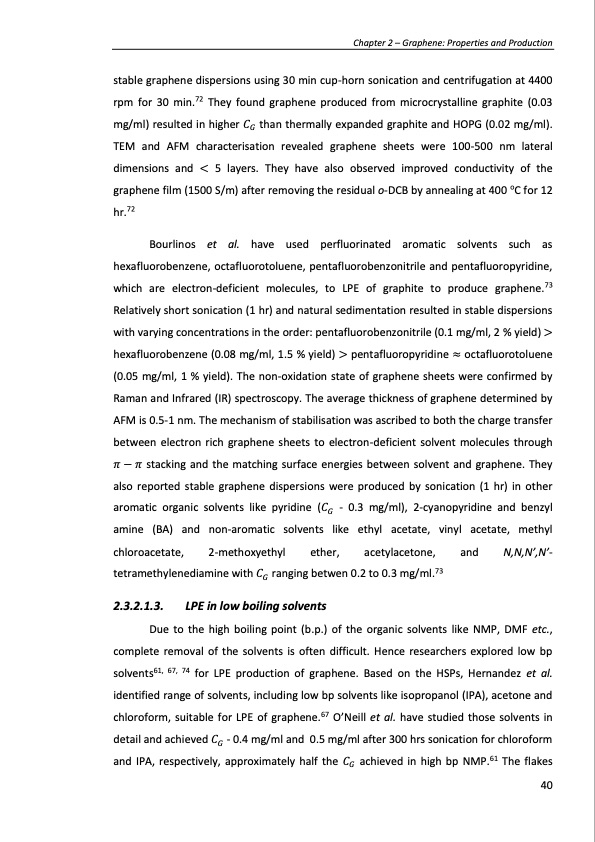
PDF Publication Title:
Text from PDF Page: 040
stable graphene dispersions using 30 min cup-horn sonication and centrifugation at 4400 rpm for 30 min.72 They found graphene produced from microcrystalline graphite (0.03 mg/ml) resulted in higher 𝐶𝐺 than thermally expanded graphite and HOPG (0.02 mg/ml). TEM and AFM characterisation revealed graphene sheets were 100-500 nm lateral dimensions and < 5 layers. They have also observed improved conductivity of the graphene film (1500 S/m) after removing the residual o-DCB by annealing at 400 oC for 12 hr.72 Bourlinos et al. have used perfluorinated aromatic solvents such as hexafluorobenzene, octafluorotoluene, pentafluorobenzonitrile and pentafluoropyridine, which are electron-deficient molecules, to LPE of graphite to produce graphene.73 Relatively short sonication (1 hr) and natural sedimentation resulted in stable dispersions with varying concentrations in the order: pentafluorobenzonitrile (0.1 mg/ml, 2 % yield) > hexafluorobenzene (0.08 mg/ml, 1.5 % yield) > pentafluoropyridine ≈ octafluorotoluene (0.05 mg/ml, 1 % yield). The non-oxidation state of graphene sheets were confirmed by Raman and Infrared (IR) spectroscopy. The average thickness of graphene determined by AFM is 0.5-1 nm. The mechanism of stabilisation was ascribed to both the charge transfer between electron rich graphene sheets to electron-deficient solvent molecules through 𝜋 − 𝜋 stacking and the matching surface energies between solvent and graphene. They also reported stable graphene dispersions were produced by sonication (1 hr) in other aromatic organic solvents like pyridine (𝐶𝐺 - 0.3 mg/ml), 2-cyanopyridine and benzyl amine (BA) and non-aromatic solvents like ethyl acetate, vinyl acetate, methyl chloroacetate, 2-methoxyethyl ether, acetylacetone, and N,N,N’,N’- tetramethylenediamine with 𝐶𝐺 ranging betwen 0.2 to 0.3 mg/ml.73 2.3.2.1.3. LPE in low boiling solvents Due to the high boiling point (b.p.) of the organic solvents like NMP, DMF etc., complete removal of the solvents is often difficult. Hence researchers explored low bp solvents61, 67, 74 for LPE production of graphene. Based on the HSPs, Hernandez et al. identified range of solvents, including low bp solvents like isopropanol (IPA), acetone and chloroform, suitable for LPE of graphene.67 O’Neill et al. have studied those solvents in detail and achieved 𝐶𝐺 - 0.4 mg/ml and 0.5 mg/ml after 300 hrs sonication for chloroform and IPA, respectively, approximately half the 𝐶𝐺 achieved in high bp NMP.61 The flakes Chapter 2 – Graphene: Properties and Production 40PDF Image | PRODUCTION AND APPLICATIONS OF GRAPHENE AND ITS COMPOSITES

PDF Search Title:
PRODUCTION AND APPLICATIONS OF GRAPHENE AND ITS COMPOSITESOriginal File Name Searched:
graphene-production-applications.PDFDIY PDF Search: Google It | Yahoo | Bing
Salgenx Redox Flow Battery Technology: Power up your energy storage game with Salgenx Salt Water Battery. With its advanced technology, the flow battery provides reliable, scalable, and sustainable energy storage for utility-scale projects. Upgrade to a Salgenx flow battery today and take control of your energy future.
| CONTACT TEL: 608-238-6001 Email: greg@infinityturbine.com | RSS | AMP |